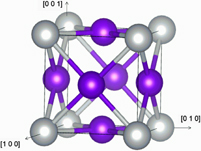Crossref Citations
This article has been cited by the following publications. This list is generated based on data provided by
Crossref.
Yıldız, Gökçen Dikici
Yıldız, Yasin Göktürk
AL, Selgin
İyigör, Ahmet
and
Arıkan, Nihat
2018.
Computational investigations of mechanic, electronic and lattice dynamic properties of yttrium based compounds.
International Journal of Modern Physics B,
Vol. 32,
Issue. 20,
p.
1850214.
Guevara, Ulises
López, Ramón
Blanco, José
and
Núñez, Jesús
2019.
Theoretical study of electronic properties and spin density in Pt-Co alloys.
Materials Research Express,
Vol. 6,
Issue. 9,
p.
096514.
Li, Zongbo
Xiong, Kai
Sun, Yingjie
Jin, Chengchen
Zhang, Shunmeng
He, Junjie
and
Mao, Yong
2020.
First-principles study of mechanical and thermodynamic properties of intermetallic Pt3M (M = Al, Hf, Zr, Co, Y, Sc).
Computational Condensed Matter,
Vol. 23,
Issue. ,
p.
e00462.
Zhang, Shuo-Xin
Liu, Shi-Yu
Yan, Da-Li
Yu, Qian
Ren, Hai-Tao
Yu, Bin
and
Li, De-Jun
2021.
First-principles study of structural stability and mechanical properties of Ta<sub>1–</sub><sub><i>x</i></sub>Hf<i><sub>x</sub></i>C and Ta<sub>1–</sub><sub><i>x</i></sub>Zr<i><sub>x</sub></i>C solid solutions.
Acta Physica Sinica,
Vol. 70,
Issue. 11,
p.
117102.
Pan, Yong
and
Yu, Ende
2021.
First-principles investigation of structural stability, mechanical and thermodynamic properties of Pt3Zr5 compounds.
Physica B: Condensed Matter,
Vol. 611,
Issue. ,
p.
412936.
Li, Zong-Bo
Xiong, Kai
Jin, Cheng-Chen
Sun, Ying-Jie
Wang, Bao-Wen
Zhang, Shun-Meng
He, Jun-Jie
and
Mao, Yong
2021.
Structural, mechanical, thermodynamic and electronic properties of Pt3M (M = Al, Co, Hf, Sc, Y, Zr) compounds under high pressure.
Rare Metals,
Vol. 40,
Issue. 5,
p.
1208.
Tak, Young Joo
Kwon, Jeong An
Shin, Dong Yun
Soon, Aloysius
and
Lim, Dong-Hee
2022.
Alternative Cu3Zn catalysts for enhanced reduction of CO2 to CH4: A density functional theory-based approach.
Surfaces and Interfaces,
Vol. 31,
Issue. ,
p.
102030.
Wei, Qun
Yan, Yaqiong
Jia, Xiaofei
Yan, Haiyan
Zhang, Meiguang
Wu, Zhenhua
and
Zhou, Yingjiao
2023.
Stability and electronic structures of Cmmm-Pt3M alloys.
Physics Letters A,
Vol. 457,
Issue. ,
p.
128540.
Sarker, Sushmita
Atikur Rahman, Md
Ali, M.S.
Roy, Dayal Chandra
Irfan, Ahmad
and
Lubna, Jannatul Ferdose
2023.
First-principles calculations to investigate elastic, electronic, optical, and thermodynamic properties of intermetallic elements Pt3T (T = Nb, Ru, Rh, Pd, and Ag).
Solid State Communications,
Vol. 376,
Issue. ,
p.
115362.
Sadat, Md Nazmus
Rahman, Md Atikur
Roy, Dayal Chandra
Rahman, Md Afjalur
Hasan, Md Zahid
Ahmad, Irfan
Chowdhury, Swapnil
Hasan, Wakil
Ferdous, Rejuana
and
Aktar, Tajrin
2024.
Study of the physical aspects of Pt3T (T = Mn, Ni) intermetallic compounds using first principles method.
Physica B: Condensed Matter,
Vol. 672,
Issue. ,
p.
415402.
Nugraha, Farhan
Aulia, Muhammad Fariz
Achmad, Tria Laksana
Tanlega, Z.
Santoso, I.
Pratama, K.
Hidayat, T.
Halim, N.
Taskinen, P.
and
Kursunoglu, S.
2024.
Effect of Alloying Compositions on the Stacking Fault Energy and Elasticity of FeNiCrAlCo and FeNiCrAlCu: A First-principles Study for Fe-based High Entropy Superalloy Design.
E3S Web of Conferences,
Vol. 543,
Issue. ,
p.
03009.
Wei, Zongfan
Xie, Yong
Xiao, Yuchen
Chen, Jiaying
Xue, Jingteng
Qu, Nan
Liu, Yong
Wu, Baoan
and
Zhu, Jingchuan
2025.
Rational analysis of atomic doping on the electronic structure and mechanical properties of Pt-based alloys.
Journal of Materials Research,
Vol. 40,
Issue. 11,
p.
1605.
Mou, Zi-shang
and
Liu, Jing-yao
2025.
Bifunctional Pt-based alloys for furfural electro-oxidation coupled with green hydrogen production.
Journal of Colloid and Interface Science,
Vol. 700,
Issue. ,
p.
138318.



